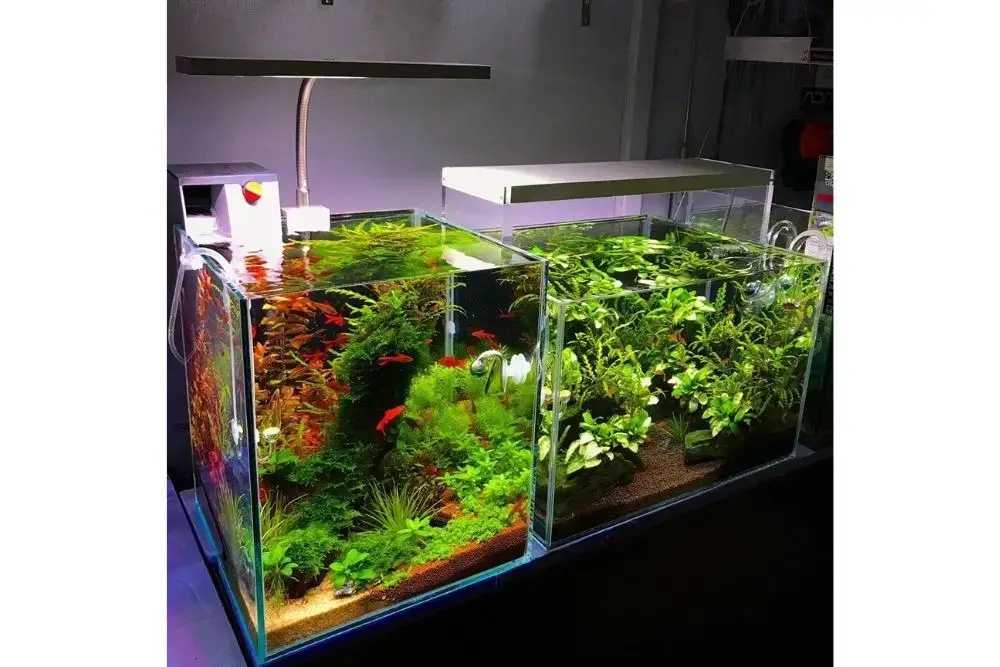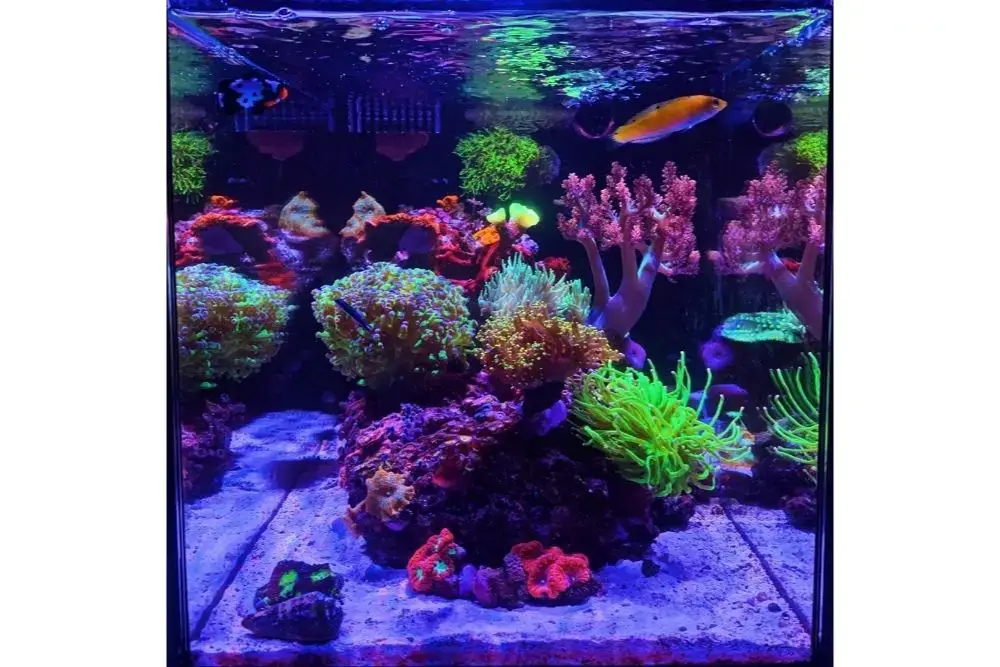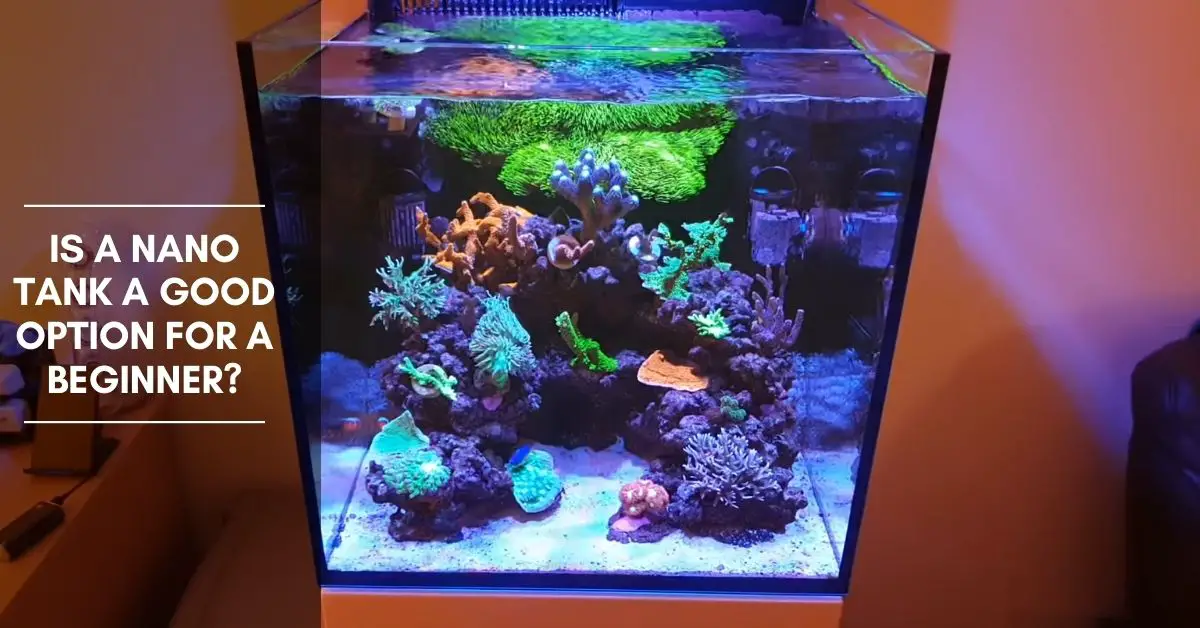For someone looking to take their first steps into the world of fishkeeping, opting for a saltwater pico tank might seem like an intelligent approach to take. After all, in most avenues of life, it is recommended to start small before graduating to bigger stuff.
So, the answer to the question ‘Is a saltwater pico Tank a good option for a beginner’ might seem like a no-brainer. However, the truth is a lot more complicated than that and today we will answer this question as clearly and lucidly as possible.
What Is A saltwater pico Aquarium?
While there is no standard size for an aquarium to be classified as a pico aquarium, it is usually a small tank with small inhabitants. The most common pico aquariums are cubical in shape with the length, breadth, and height being somewhere around one foot or thirty centimeters each. While there is some leeway to the exact shape and size, aquariums that are close to this dimension are considered pico tanks.

What Makes Pico Aquariums Unsuitable For Beginners?
It might seem quite obvious that a marine or reef pico tank would be the right way for a beginner to gain experience in the hobby. These tanks cost less, take up less space, and do not weight a lot. However, the reality is quite different, and here are the main reasons why beginners should avoid them.
Difficult To Maintain Stable Water Conditions
To better understand this problem, it is important to be aware of how an aquarium can stay healthy. The most important factor is stability. Every fish and invertebrate has a safe range of water parameters such as temperature, pH, hardness, and the concentration of various chemicals. Not only must these water conditions stay within this range but it should also stay fairly consistent. Ensuring this is quite challenging in a pico tank.
The natural habitats of most fishes usually contain thousands of gallons of water at the very least. Any change in such a system would take place very gradually which would allow the fish a lot more time to get acclimatized to the change. As the volume of water gets lower, the time required for any change to occur also becomes shorter.
API STRESS ZYME Freshwater and Saltwater Aquarium Cleaning Solution 16-Ounce Bottle
API ACCU-CLEAR Freshwater Aquarium Water Clarifier 4-Ounce Bottle
30% OffTetra Water Clarifier, Aquarium Treatment Solution, 8.45 oz, Clears Cloudy Aquarium Water, Safe to Use with Fish and Plants, For Fresh Water
$8.49 (as of June 29, 2025 06:58 GMT +03:00 - More infoProduct prices and availability are accurate as of the date/time indicated and are subject to change. Any price and availability information displayed on [relevant Amazon Site(s), as applicable] at the time of purchase will apply to the purchase of this product.)In a reef pico tank, the total volume of water is so low that fluctuations in temperature, pH, and chemical concentrations can take place rather rapidly. This can be extremely dangerous for the fish and even the hardiest fish won’t be able to survive under such conditions.
The argument could be made that such fluctuations could be avoided through careful monitoring. However, that would be too much work for a beginner. Another thing worth remembering is that equipment failures occur all the time even in the most fastidiously maintained aquariums.
The chances of that happening in an aquarium being looked after by someone new to the hobby is even higher and if the tank in question is a pico tank, it would only take a very short amount of time for the water parameters to reach a stage that is fatal for the inhabitants of the tank.
Even if there is no equipment failure, things can go out of balance quite quickly. Uneaten food, sunlight, rotting vegetation, and a number of other things can cause the water parameter to fluctuate quickly in small aquariums. Water changes also have to be done more frequently and with extra care to ensure that the temperature and pH values do not vary too much which is again a task that can be too daunting for a beginner.

Limited Choice Of Fish And Decor
What should be obvious is that a small tank can only accommodate small fish and in fewer numbers. While this might seem okay at first, people can soon outgrow the limited choice they have. There are a few beautiful and interesting fish species that stay small but options are fairly limited. Since they cannot be kept in large numbers either, that tank can get a bit uninteresting quite rapidly.
Another issue that a beginner will certainly run into will be the decor options. Most people get attracted to the notion of keeping a reef pico tank after seeing a stunning example of it in aquarium stores or in places like malls and exhibitions. However, what they fail to realize is that these pico tanks are almost always set up and maintained by professionals. They use highly specialized and expensive equipment to do so, all of which will put the possibility of replicating something similar out of the reach of a beginner hobbyist.
Why A Larger Aquarium Is Better For Beginners?
If you are out and about looking to buy your first aquarium then the golden rule is to go for the biggest aquarium you can afford and accommodate. They are a lot more forgiving as any changes in the water parameters will take place much more gradually and that should give a beginner hobbyist enough opportunities to take preventive measures.
There is also a bit more leeway when it comes to maintenance making it a lot less hectic for someone who is still learning the tricks of the trade. As an added bonus, you will also have a lot more choice when it comes to choosing the fish and setting the tank up exactly as you want with more flexibility when it comes to decor.
While this approach can be expensive initially, in the long run, it will actually save you time and energy while also giving your fishes more room to live out their lives happily.
Who Should Keep A Saltwater Pico Aquarium?
Now that we have cleared up why beginners should stay away from pico tanks, it is worth touching upon the actual people such tanks are meant for. The ideal hobbyist capable of keeping a pico aquarium would be someone who has a few years of experience and already has at least one other aquarium. In such cases, a saltwater pico tank could be the perfect way to expand on their hobby.
By this stage, they would be experienced enough to be better equipped to handle all the challenges associated with keeping a smaller tank successfully. Fishkeeping is an utterly rewarding hobby when done right and if you are a beginner stay away from pico tanks for the time being to avoid heartache and unnecessary challenges.

Hi, my name is Sean, and I’m the primary writer on the site. I’m blogging mostly about freshwater and saltwater aquariums, fish, invertebrates, and plants. I’m experienced in the fishkeeping hobby for many years. Over the years I have kept many tanks, and have recently begun getting more serious in wanting to become a professional aquarist. All my knowledge comes from experience and reading forums and a lot of informative sites. In pursuit of becoming a professional, I also want to inspire as many people as I can to pick up this hobby and keep the public interest growing.
Read more about Sean.
Please join also my Facebook group.




















